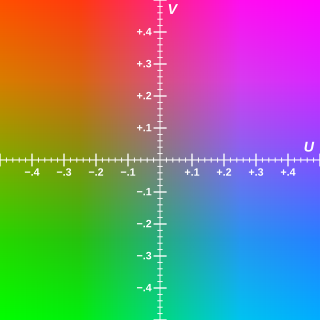
Y′UV, also written YUV, is the color model found in the PAL analogue color TV standard. A color is described as a Y′ component (luma) and two chroma components U and V. The prime symbol (') denotes that the luma is calculated from gamma-corrected RGB input and that it is different from true luminance. Today, the term YUV is commonly used in the computer industry to describe colorspaces that are encoded using YCbCr.

The CIELAB color space, also referred to as L*a*b*, is a color space defined by the International Commission on Illumination in 1976. It expresses color as three values: L* for perceptual lightness and a* and b* for the four unique colors of human vision: red, green, blue and yellow. CIELAB was intended as a perceptually uniform space, where a given numerical change corresponds to a similar perceived change in color. While the LAB space is not truly perceptually uniform, it nevertheless is useful in industry for detecting small differences in color.
Chromatic adaptation is the human visual system’s ability to adjust to changes in illumination in order to preserve the appearance of object colors. It is responsible for the stable appearance of object colors despite the wide variation of light which might be reflected from an object and observed by our eyes. A chromatic adaptation transform (CAT) function emulates this important aspect of color perception in color appearance models.

YCbCr, Y′CbCr, or Y Pb/Cb Pr/Cr, also written as YCBCR or Y′CBCR, is a family of color spaces used as a part of the color image pipeline in video and digital photography systems. Y′ is the luma component and CB and CR are the blue-difference and red-difference chroma components. Y′ is distinguished from Y, which is luminance, meaning that light intensity is nonlinearly encoded based on gamma corrected RGB primaries.
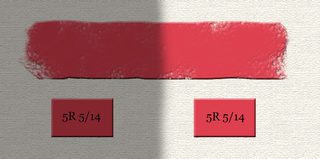
Colorfulness, chroma and saturation are attributes of perceived color relating to chromatic intensity. As defined formally by the International Commission on Illumination (CIE) they respectively describe three different aspects of chromatic intensity, but the terms are often used loosely and interchangeably in contexts where these aspects are not clearly distinguished. The precise meanings of the terms vary by what other functions they are dependent on.
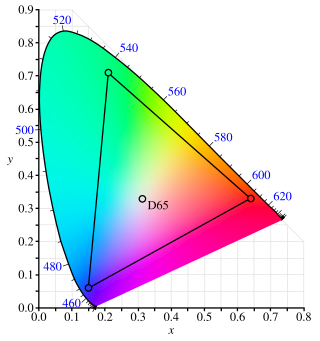
The Adobe RGB (1998) color space or opRGB is a color space developed by Adobe Inc. in 1998. It was designed to encompass most of the colors achievable on CMYK color printers, but by using RGB primary colors on a device such as a computer display. The Adobe RGB (1998) color space encompasses roughly 50% of the visible colors specified by the CIELAB color space – improving upon the gamut of the sRGB color space, primarily in cyan-green hues. It was subsequently standardized by the IEC as IEC 61966-2-5:1999 with a name opRGB and is used in HDMI.
In mathematics, the discrete Laplace operator is an analog of the continuous Laplace operator, defined so that it has meaning on a graph or a discrete grid. For the case of a finite-dimensional graph, the discrete Laplace operator is more commonly called the Laplacian matrix.

The CIE 1931 color spaces are the first defined quantitative links between distributions of wavelengths in the electromagnetic visible spectrum, and physiologically perceived colors in human color vision. The mathematical relationships that define these color spaces are essential tools for color management, important when dealing with color inks, illuminated displays, and recording devices such as digital cameras. The system was designed in 1931 by the "Commission Internationale de l'éclairage", known in English as the International Commission on Illumination.

LMS, is a color space which represents the response of the three types of cones of the human eye, named for their responsivity (sensitivity) peaks at long, medium, and short wavelengths.
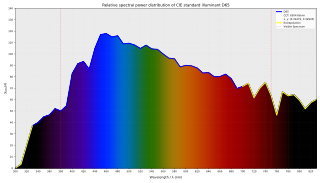
CIE standard illuminant D65 (sometimes written D65) is a commonly used standard illuminant defined by the International Commission on Illumination (CIE). It is part of the D series of illuminants that try to portray standard illumination conditions at open-air in different parts of the world.
Relative luminance follows the photometric definition of luminance including spectral weighting for human vision, but while luminance is a measure of light in units such as , Relative luminance values are normalized as 0.0 to 1.0, with 1.0 being a theoretical perfect reflector of 100% reference white. Like the photometric definition, it is related to the luminous flux density in a particular direction, which is radiant flux density weighted by the luminous efficiency function y(λ) of the CIE Standard Observer.

A standard illuminant is a theoretical source of visible light with a spectral power distribution that is published. Standard illuminants provide a basis for comparing images or colors recorded under different lighting.
In statistics, the Kendall rank correlation coefficient, commonly referred to as Kendall's τ coefficient, is a statistic used to measure the ordinal association between two measured quantities. A τ test is a non-parametric hypothesis test for statistical dependence based on the τ coefficient. It is a measure of rank correlation: the similarity of the orderings of the data when ranked by each of the quantities. It is named after Maurice Kendall, who developed it in 1938, though Gustav Fechner had proposed a similar measure in the context of time series in 1897.
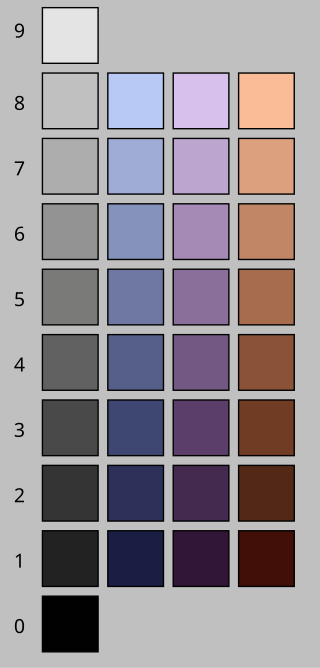
Lightness is a visual perception of the luminance of an object. It is often judged relative to a similarly lit object. In colorimetry and color appearance models, lightness is a prediction of how an illuminated color will appear to a standard observer. While luminance is a linear measurement of light, lightness is a linear prediction of the human perception of that light.
In colorimetry, the CIE 1976L*, u*, v*color space, commonly known by its abbreviation CIELUV, is a color space adopted by the International Commission on Illumination (CIE) in 1976, as a simple-to-compute transformation of the 1931 CIE XYZ color space, but which attempted perceptual uniformity. It is extensively used for applications such as computer graphics which deal with colored lights. Although additive mixtures of different colored lights will fall on a line in CIELUV's uniform chromaticity diagram, such additive mixtures will not, contrary to popular belief, fall along a line in the CIELUV color space unless the mixtures are constant in lightness.
In color science, color difference or color distance is the separation between two colors. This metric allows quantified examination of a notion that formerly could only be described with adjectives. Quantification of these properties is of great importance to those whose work is color-critical. Common definitions make use of the Euclidean distance in a device-independent color space.

The CIE 1960 color space ("CIE 1960 UCS", variously expanded Uniform Color Space, Uniform Color Scale, Uniform Chromaticity Scale, Uniform Chromaticity Space) is another name for the (u, v) chromaticity space devised by David MacAdam.
A color appearance model (CAM) is a mathematical model that seeks to describe the perceptual aspects of human color vision, i.e. viewing conditions under which the appearance of a color does not tally with the corresponding physical measurement of the stimulus source.

ICTCP, ICtCp, or ITP is a color representation format specified in the Rec. ITU-R BT.2100 standard that is used as a part of the color image pipeline in video and digital photography systems for high dynamic range (HDR) and wide color gamut (WCG) imagery. It was developed by Dolby Laboratories from the IPT color space by Ebner and Fairchild. The format is derived from an associated RGB color space by a coordinate transformation that includes two matrix transformations and an intermediate nonlinear transfer function that is informally known as gamma pre-correction. The transformation produces three signals called I, CT, and CP. The ICTCP transformation can be used with RGB signals derived from either the perceptual quantizer (PQ) or hybrid log–gamma (HLG) nonlinearity functions, but is most commonly associated with the PQ function.
Hunter Lab is a color space defined in 1948 by Richard S. Hunter. It was designed to be computed via simple formulas from the CIEXYZ space, but to be more perceptually uniform. Hunter named his coordinates L, a and b. Hunter Lab was a precursor to CIELAB, created in 1976 by the International Commission on Illumination (CIE), which named the coordinates for CIELAB as L*, a*, b* to distinguish them from Hunter's coordinates.






































